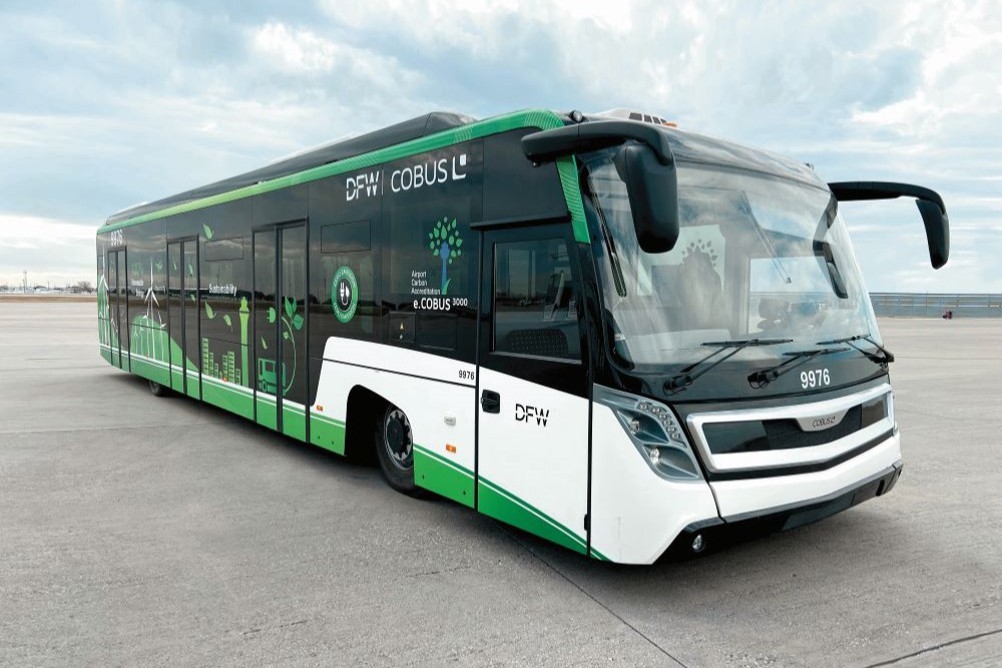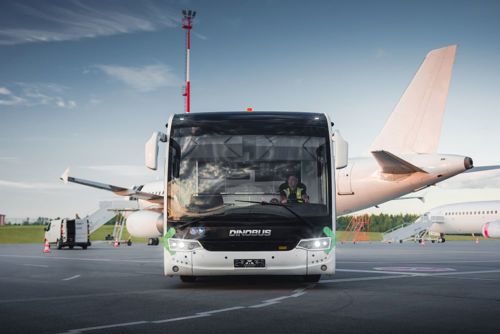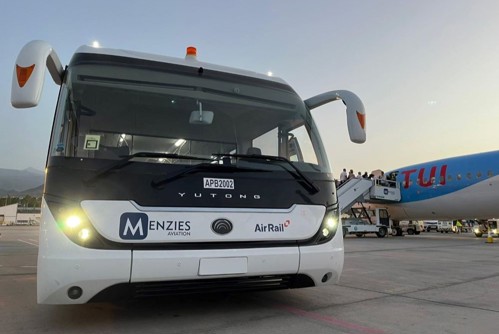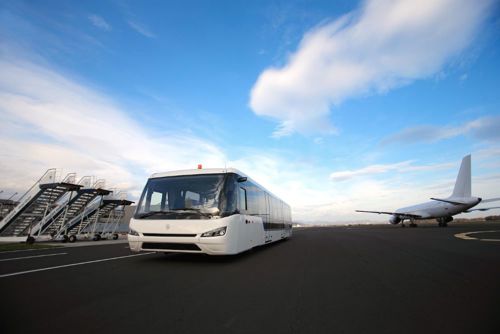
Picture credit: COBUS
When passengers are picked up or dropped off at faraway stands, they want the bus journey to be smooth and comfortable or this will become another cause for irritation after any inconvenience in the terminal.
The manufacturers of airport buses have invested time and money in making buses more comfortable for passengers and the driver, and to make them more efficient and reliable.
Ever since travel restrictions were lifted, passenger demand has been strong, which has resulted in demand to upgrade fleets including new buses.
Patricia Vasconcelos, CEO of COBUS Industries reports demand was strong last year driven by the company’s focus on sustainability and innovation.
Demand was boosted by the lifting of pandemic restrictions, with Vasconcelos saying: “Last year saw a marked increase in orders for airport buses, reflecting the rebound in global air travel. This year, the demand remains strong, with a particularly notable surge in interest for electric-powered buses. Looking ahead to the rest of 2024 and into 2025, we anticipate continued growth as airports worldwide seek to modernise their fleets with more sustainable options.”
COBUS Industries has extensive experience in electric-powered buses, having launched the e.COBUS in 2015, offering diesel-to-electric e.START conversions, developing the e.COBUS Extended Range models and the upcoming Vega.
The COBUS Vega was unveiled at GSE Expo Europe 2022 and received positive market feedback.
Vasconcelos said: “Customers appreciate the benefits of a purpose-built electric bus, which include improved energy efficiency, reduced emissions, and enhanced passenger comfort. We look forward to presenting the COBUS Vega at the GSE Expo Europe 2024 in Lisbon on 17-19 September to announce the official product launch.”
Lower operational costs, reduced maintenance tasks make electric-powered buses more cost efficient and they have the range because hardstand operations often offer enough time to recharge them.
A decade ago COBUS Industries was at the forefront of electric-powered buses, now it is developing the COBUS Hydra, the world’s first hydrogen-powered airport bus.
The COBUS Hydra uses safe and proven Toyota Fuel Cell Stack technology, offers a range of up to 400km and can be refilled in less than nine minutes depending on the station.
Vasconcelos said: “While demand for hydrogen vehicles is still emerging, we are closely monitoring developments in this area. We believe there is potential for both electric and hydrogen-powered buses in the market, each offering unique benefits depending on specific operational needs and areas worldwide.”
There is still a need for internal combustion engines because there are regions of the world where electric- or hydrogen-powered vehicles are not practical, she adds.
“Our designs ensure that all COBUS airside buses are reliable, efficient, and comfortable, meeting the high standards expected by operators and passengers alike,” said Vasconcelos.

New arrival
The DINOBUS was unveiled last year and has received positive feedback, says Partnership Development Officer Tomas Puodziunas.
Since development started in 2022, six units have entered service.
He said: “The market is always welcoming new players and suppliers, and since DINOBUS offers highly competitive pricing and a supportive warranty strategy, the market reactions were indeed very positive. From the moment we came on the scene in 2023, we’ve been seeing a steady growth of interest in the fully electric DINOBUS models.”
Customers have praised how smoothly the DINOBUS drives, its simple controls, the ride and brakes.
Puodziunas says the steering assistance makes the driver feel that they are operating a car, not a large, heavy bus.
They are also finding that electric buses improve efficiency and productivity compared to buses with internal combustion engines.
Commenting on charging infrastructure, Puodziunas said: “Charging infrastructure needs to undergo the same upgrading process as all GSE. Therefore, a crucial number of airports are installing solar panels at their fields, building roofs, and implementing new and sustainable approaches to energy supply that meet their needs.”
The post-pandemic path focuses on sustainability, which includes looking at the ramp environment.
Puodziunas said: “All new airport ground handling operation licences are obligated to bring forth sustainability, and this cannot be done without adding electric airport buses to the equation. At DINOBUS, we are forecasting a very successful decade for electric apron bus sales across the globe.”

China’s top export brand
Yutong is the top Chinese airport bus brand and demand will go up as the aviation market recovers from the pandemic.
Its buses are in use at more than 70 airports globally and Yutong has a market share exceeding 40%.
Electric-powered buses have proved popular with Yutong selling more than 200 AB14Es since its launch in 2016. In China, it has a market share of more than 60%.
Customers find that the repair, maintenance and energy consumption of electric-powered buses are lower than buses powered by internal combustion engines.
William, Account Manager at Yutong said: “In 2022, Yutong comprehensively upgraded the shuttle bus and launched the second generation of pure electric airport shuttle, which has been greatly improved and upgraded from appearance to vehicle configuration functions.”
To make its buses comfortable and practical, they have airbag suspension with a roll function to make passenger boarding more convenient and customised variable damping shock absorbers to make the ride more comfortable.
To reduce roll while turning, a lateral stabiliser bar is fitted to the chassis.
Inside, the passenger area has been designed without sharp corners to avoid passenger injury with Yutong highlighting that it has developed a TPU material pull ring and the heating system has been concealed.
For the summer, Yutong’s buses have high-powered air conditioning and are equipped with environmentally-friendly, high-powered electric heating devices for use in the winter.
For the three electric system, cathode electrocoating technology has been imported from Germany.
William continued: “Yutong’s protection level reaches IP68+IP6K9K, the highest protection level in the industry, and the power battery matching nitrogen protection device and 24h all-weather monitoring system can ensure the safety of the battery.”
Demand for airport buses will rise as travel demand returns to normal and buses need to be more environmentally-friendly to decarbonise aviation.
William added: “As countries advocate the concept of “green travel”, this will promote the use of pure electric airport apron buses. The increase of battery mileage and charging time, as well as the reduction of battery prices, will bring electric vehicles into the mainstream.”

Fleet modernisation
Strong travel demand in 2023 resulted in high demand for airport buses with TAM Europe Vice President Matej Smrekar saying its VivAir series is proving popular for airports looking to modernise and expand their fleets to serve a growing number of passengers.
Smrekar says customers like the way the VivAir combines design, function and comfort in an economical machine, which is reliable and versatile.
Demand has remained strong in 2024, particularly for electric and hydrogen buses as operators look for green solutions.
He said: “The VivAir series, with its range of options including diesel, electric, and CNG drivetrains, has been especially popular. We anticipate this trend to persist, with further growth expected as we introduce our hydrogen bus at the beginning of 2025.”
TAM Europe launched the electric eVivAir in September 2018, which has been tested extensively by airlines who have praised it for its performance and passenger comfort, saying it is efficient, reliable and offers environmental benefits.
Electric-powered buses are in demand across Europe, North America and parts of Asia, with Smrekar adding that there is a preference for diesel buses in parts of Africa and the Middle East due to infrastructure constraints and the availability of diesel fuel.
In these regions, the diesel-powered VivAir, with its MAN common rail engine and robust design is still the vehicle of choice.
There is still a place for diesel buses because electric-powered buses are not practical everywhere with Smrekar saying: “At TAM, we are committed to making our diesel vehicles more efficient and environmentally friendly by incorporating advanced technologies such as cleaner burning engines, improved aerodynamics, and lightweight materials to reduce fuel consumption and emissions.”
Airport buses need to be efficient, reliable and robust so they can withstand continuous operation, and they feature advanced safety features and optimise energy efficiency.
TAM Europe focuses on spacious interiors, ergonomic seating, climate control systems and easy access for passengers with reduced mobility so they are comfortable for passengers.
The VivAir series has five basic models and a VIP luxury version, offering customers various options.
There are two different widths and three lengths available, and the VivAir can have up to seven doors.
Smrekar said: “Our buses are custom-made and adjustable to customer wishes, ensuring they meet specific operational needs. We also provide 24/7 service and aftersales assistance to ensure our customers receive ongoing support.”
The airport bus market is looking for sustainable options with electric and hydrogen power units becoming an increasingly common sight.
Smrekar says TAM wants to lead the way in creating a sustainable future, adding, “The VivAir series, with its diverse options and customisation capabilities, will continue to set the standard for efficiency, passenger comfort, and adaptability to customer needs. Our commitment to providing 24/7 service and aftersales assistance will ensure that we maintain the highest standards of customer satisfaction.”
This article was published in the June 2024 issue of Ground Handling International, click here to read the digital edition and click here to subscribe.






